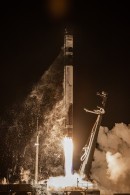Today, June 28th, Rocket Lab's Electron rocket successfully carried beyond our skies the CAPSTONE mission, a CubeSat as big as a microwave oven designed to explore the same orbit planned for NASA's Gateway – a multipurpose outpost part of the Artemis program that will circle the Moon and support a long-term human presence on the lunar surface.
With the Artemis missions, NASA plans to return humans to the lunar surface and explore the satellite more than ever before. The Gateway is essential for establishing a long-term presence around and on the Moon. It will be the first space station to orbit the satellite. The outpost will help the agency extend the mission duration, providing unique benefits to astronauts.
CAPSTONE (the Cislunar Autonomous Positioning System Technology Operations and Navigation Experiment) supports the Artemis program. On Tuesday, an Electron rocket carrying the small CubeSat blasted into space from New Zealand.
The spacecraft is now mounted on top of Rocket Lab's Lunar Photon third stage. Photon will gradually move beyond low-Earth orbit over the following several days and then release CAPSTONE. To travel the remaining distance to the Moon, the CubeSat will use its own propulsion.
It will take around four months to reach its destination. When the spacecraft arrives at the Moon's orbit, it will fly within 1,000 miles (1,609 km) above the satellite's North Pole on its closest pass and 43,500 miles (70,000 km) from the South Pole on its furthest pass.
The spacecraft will then continue to circle the Moon for about half a year, helping scientists better understand the characteristics of the orbit. During this time, it will also validate technologies that will help pave the way for NASA's Gateway.
"CAPSTONE is a pathfinder in many ways, and it will demonstrate several technology capabilities during its mission timeframe while navigating a never-before-flown orbit around the Moon," said Elwood Agasid, project manager for CAPSTONE at NASA's Ames Research Center.
CAPSTONE will use a dedicated payload flight computer and communications system to determine the distance between itself and NASA's Reconnaissance Orbiter. The data gathered will be used to assess CubeSat's autonomous navigation software. If successful, future spacecraft will be able to establish their location without relying solely on tracking from Earth.
CAPSTONE (the Cislunar Autonomous Positioning System Technology Operations and Navigation Experiment) supports the Artemis program. On Tuesday, an Electron rocket carrying the small CubeSat blasted into space from New Zealand.
The spacecraft is now mounted on top of Rocket Lab's Lunar Photon third stage. Photon will gradually move beyond low-Earth orbit over the following several days and then release CAPSTONE. To travel the remaining distance to the Moon, the CubeSat will use its own propulsion.
It will take around four months to reach its destination. When the spacecraft arrives at the Moon's orbit, it will fly within 1,000 miles (1,609 km) above the satellite's North Pole on its closest pass and 43,500 miles (70,000 km) from the South Pole on its furthest pass.
The spacecraft will then continue to circle the Moon for about half a year, helping scientists better understand the characteristics of the orbit. During this time, it will also validate technologies that will help pave the way for NASA's Gateway.
"CAPSTONE is a pathfinder in many ways, and it will demonstrate several technology capabilities during its mission timeframe while navigating a never-before-flown orbit around the Moon," said Elwood Agasid, project manager for CAPSTONE at NASA's Ames Research Center.
CAPSTONE will use a dedicated payload flight computer and communications system to determine the distance between itself and NASA's Reconnaissance Orbiter. The data gathered will be used to assess CubeSat's autonomous navigation software. If successful, future spacecraft will be able to establish their location without relying solely on tracking from Earth.
Liftoff! #CAPSTONE launched aboard a @RocketLab Electron rocket to pave the way for future @NASAArtemis missions to the Moon and beyond.
— NASA (@NASA) June 28, 2022
What’s next for the microwave oven-sized satellite? Check out https://t.co/dMVnvEQcfC for updates. pic.twitter.com/VVoAOjSYbD






